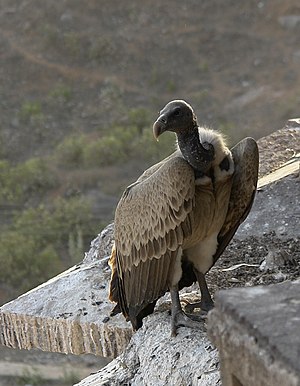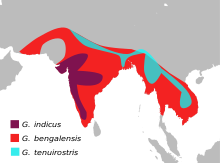Indian vulture
| Indian vulture | ||||||||||||
|---|---|---|---|---|---|---|---|---|---|---|---|---|

Indian vulture ( Gyps indicus ) |
||||||||||||
| Systematics | ||||||||||||
|
||||||||||||
| Scientific name | ||||||||||||
| Gyps indicus | ||||||||||||
| ( Scopoli , 1786) |
The Indian vulture ( Gyps indicus ), sometimes also called the Indian vulture , is a bird of prey from the subfamily of the Old World vultures (Aegypiinae).
features
Adult Indian vultures reach a wingspan of 196 to 228 centimeters, a body length of 80 to 103 centimeters and a weight of 5.5 to 6.3 kilograms. The head and neck are darkly colored and bare, the ruff is fletched whitish. It has very broad wings and short tail feathers. The fletching on the back and the upper wing coverts are yellowish brown, the belly feathers are usually lighter yellowish brown. The beak is pale yellow. The thighs are densely white-gray feathered.
Very similar to the Indian vulture is the thin-billed vulture ( Gyps tenuirostris ), which has long been a subspecies and was recognized by Rasmussen as a separate species. It is built a little more robustly and shows a longer and lighter colored beak. Its distribution area includes a belt south of the Himalayas and extends to Southeast Asia. There is therefore no geographical overlap between the two species, which makes it easier to distinguish between them.
Geographical distribution and habitat
Indian vultures occur in eastern Pakistan , along the west coast of the Indian peninsula as well as in the north of Delhi and south of the headwaters of the Ganges . They colonize cities and villages as well as open landscapes and forests.
Way of life
The Indian vulture is a pure scavenger that usually finds itself in large groups of animal carcasses to eat.
The breeding season for the Indian vulture is from November to March. Indian vultures are mostly sociable and breed on rocks and on dilapidated buildings. Where both are missing, they sometimes breed on trees.
Hazards and protective measures
According to the status of the IUCN, the species is critically endangered. The population has decreased by 97 percent since the mid-1990s. After it was initially suspected that the vultures had succumbed to an infectious disease, after examining tissue samples it was determined that the active ingredient diclofenac is responsible for the death of the birds. Diclofenac is an anti-inflammatory drug used to treat injured domestic cattle. If a cattle treated with it died and vultures ate from the carcass, they died of kidney failure. Because diclofenac is widely used in South Asia, it also poses a constant threat to all vulture populations living in the affected regions. This is particularly true in areas with Hinduism who do not eat beef and do not dispose of the dead cattle. It is therefore eaten by the vultures at the point where it perished. After the harmful effects of diclofenac on the vultures were recognized, its use in domestic animals was banned in India. This is also because with the decline in the number of vultures, an increase in rat populations and feral dogs, which mainly fed on carrion, was recorded. The anti-inflammatory drug Meloxicam is an alternative that does not harm the vulture's health, but is more expensive. Diclofenac is therefore still used illegally in India.
In the meantime, various conservation breeding programs have been started, including in the offspring station in Haryana . As a further protective measure, untreated cadavers are laid out in selected places in order to bind the vultures, which are very faithful to their location, to these places until diclofenac has largely disappeared from the food cycle.
Individual evidence
- ↑ biomedcentral
- ↑ globalraptors
- ^ Birdlife
- ^ Iucnredlist
- ↑ Nature Conservation Union Germany
- ↑ Prakash, V .; Pain, DJ; Cunningham, AA; Donald, PF; Prakash, N .; Verma, A .; Gargi, R .; Sivakumar, S .; Rahmani, AR 2003. Catastrophic collapse of Indian white-backed Gyps bengalensis and long-billed Gyps indicus vulture populations. Biological Conservation 109: 381-390.
literature
- Pamela C. Rasmussen and John C. Anderton: Birds of South Asia. The Ripley Guide , 2005, ISBN 84-87334-67-9
- Ferguson-Lees, Christie, Franklin, Mead & Burton. Raptors of the World , Houghton Mifflin, 2001, ISBN 0-618-12762-3
- Dominic Couzens : Rare Birds - Survivors, Evolution Losers and the Lost. Haupt Verlag, Bern 2011, ISBN 978-3-258-07629-4 .
- Rasmussen, PC, and SJ Parry (2001): The taxonomic status of the "Long-billed" Vulture Gyps indicus . Vulture News 44: 18-21.
Web links
- Gyps indicus in the endangered Red List species the IUCN 2012. Posted by: BirdLife International, 2012. Accessed December 16, 2012 found.

